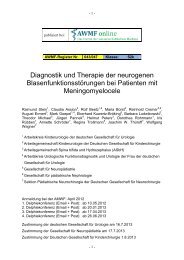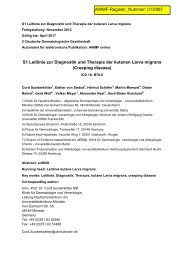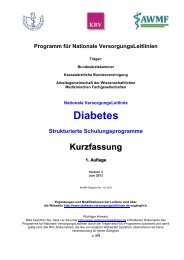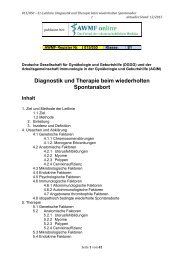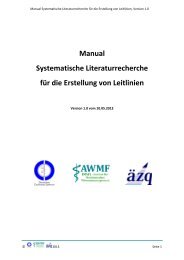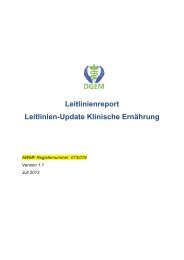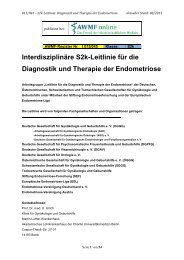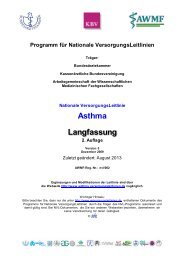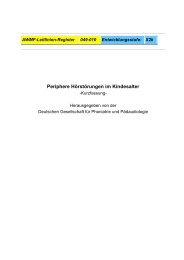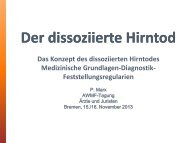Guideline on Treatment of Patients with Severe and Multiple ... - AWMF
Guideline on Treatment of Patients with Severe and Multiple ... - AWMF
Guideline on Treatment of Patients with Severe and Multiple ... - AWMF
You also want an ePaper? Increase the reach of your titles
YUMPU automatically turns print PDFs into web optimized ePapers that Google loves.
S3 <str<strong>on</strong>g>Guideline</str<strong>on</strong>g> <strong>on</strong> <strong>Treatment</strong> <strong>of</strong> <strong>Patients</strong> <strong>with</strong> <strong>Severe</strong> <strong>and</strong> <strong>Multiple</strong> Injuries<br />
56%, 81% <strong>and</strong> 91%). The specific success rates <strong>of</strong> endotracheal intubati<strong>on</strong> by paramedics, nurses<br />
<strong>and</strong> emergency physicians were not broken down further. The results <strong>of</strong> this study [101] show<br />
that the cumulative success rate <strong>of</strong> endotracheal intubati<strong>on</strong> in a paramedic system is markedly<br />
below that <strong>of</strong> emergency physician systems staffed solely by anesthesiologists, whose rate is 97-<br />
100% [48, 92, 94]. However, the administrati<strong>on</strong> <strong>of</strong> drugs, as they are used during a rapid<br />
sequence inducti<strong>on</strong> (including muscle relaxants), helps to facilitate endotracheal intubati<strong>on</strong> in<br />
patients <strong>with</strong>out cardiac arrest <strong>and</strong> thus leads to a markedly higher intubati<strong>on</strong> success. Both are<br />
frequently vital for survival in an emergency situati<strong>on</strong>. According to the above-cited study<br />
results, alternative methods should be c<strong>on</strong>sidered for securing an airway after more than 3<br />
intubati<strong>on</strong> attempts [4, 65]. Although fiberoptic procedures are <strong>on</strong>ly available in isolated cases in<br />
the prehospital phase, fiberoptic intubati<strong>on</strong> must be available in-hospital. In all comm<strong>on</strong><br />
guidelines <strong>and</strong> recommendati<strong>on</strong>s <strong>on</strong> emergency airway securing, (awake) fiberoptic intubati<strong>on</strong> is<br />
c<strong>on</strong>sidered a possible procedure for securing an airway if there is appropriate experience <strong>and</strong><br />
appropriate envir<strong>on</strong>mental c<strong>on</strong>diti<strong>on</strong>s [33, 46, 49, 59].<br />
In c<strong>on</strong>trast, emergency cricothyroidotomy is simply the last resort in a “cannot ventilate - cannot<br />
intubate” situati<strong>on</strong> to secure ventilati<strong>on</strong> <strong>and</strong> oxygenati<strong>on</strong> in an emergency. In nati<strong>on</strong>al <strong>and</strong><br />
internati<strong>on</strong>al recommendati<strong>on</strong>s <strong>and</strong> guidelines, emergency cricothyroidotomy has a firm place in<br />
prehospital <strong>and</strong> hospital phases <strong>and</strong> is indicated if alternative methods for securing an airway <strong>and</strong><br />
bag-valve-mask ventilati<strong>on</strong> are not successful [9, 46, 49, 70].<br />
Prehospital – Airway management, ventilati<strong>on</strong> <strong>and</strong> emergency anesthesia 27




